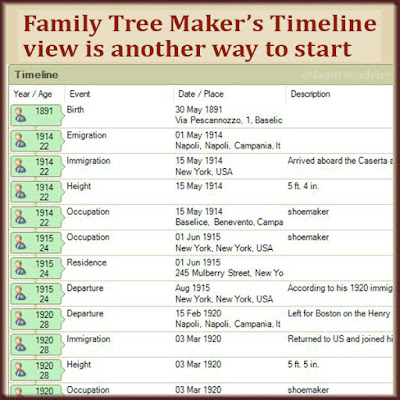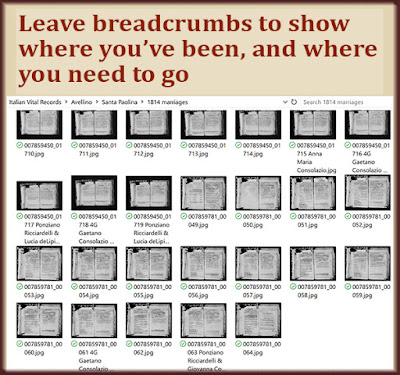You've got the raw materials. Shape them into a remembrance of your ancestor.
Have you ever thought of writing about your family history? Do you have an ancestor who's interesting enough to write a whole book about, but you don't know where to start?
It's very possible you haven't started because the whole project seems too big.
 |
| Your tree on Ancestry.com has a LifeStory view. |
Let's end that problem here and now. Stop thinking of your ancestor's story as a book. Don't even think about it as a short story.
Break things down to 5 simple steps and watch the project take on a life of its own. To show you this simple process, I'll use my grandfather Adamo Leone as an example. Since he was a World War I veteran, this is good timing.
Step 1: Gather Basic Facts
I've gathered almost every major document possible for my grandfather. Only his naturalization papers are missing. I'll start this process by looking at this facts chronologically.
In my Family Tree Maker software I can view a timeline of every recorded fact. On Ancestry.com I can view his "LifeStory".
No matter how you view your collected facts, this is where you'll begin. Use whatever word processing software you prefer. Put your ancestor's name at the top and start a bulleted list using the simple format of Date: Event.
 |
| Family Tree Maker has a nice timeline view. Does your software? |
Copy the main facts, in order, into your outline. Try to use complete sentences, but don't worry about making things perfect. If you're inspired to add a sentence or two to describe something about a fact, go right ahead.
Step 2: Add Historical Context
My grandfather fought in World War I and was a prisoner of war in Austria for a year. I've gathered facts about the battle where he and 300,000 other Italian soldiers were captured. Earlier this year I went to Italy and photographed his Italian military record. That document is packed with dates I can add to his timeline.
I'll add the name and date of his battle. I'll add the dates of his imprisonment. I'll add the time he spent recuperating before returning to New York.
I'll add some facts I've gathered about the places he worked or owned a shoe store.
In short, I'll try to paint a picture of what was going on in my grandfather's life and in the world.
Step 3: Add Documents and Photos
You don't want to make your file too big to share. So don't add every document you've collected to this file.
There's probably no one who cares as much about every single census record as you do. Be conservative as you add images to your ancestor's life story.
Place some photos and document images where they belong in the timeline.
 |
| When you break it down, writing your ancestor's story can be pretty easy. |
Step 4: Personalize Facts with Basic Details
Now that you've got so many facts listed in chronological order, it won't be hard to make them more fun to read.
Go through all the facts one by one. Add words to make more complete sentences. Add details that you know from memory or from family stories.
For instance, when my grandfather had his own shoe repair store, he once made shoes for the famous actress Gloria Swanson. She was only 5’1” tall and had tiny feet. She wore a size 4 shoe. Sometimes he would make sample shoes for her. If there were any that she didn’t want, Adamo brought them home to his wife, Mary. No matter how tiny the sample shoes were, she would cram her feet in there and wear them proudly. Eventually he stopped bringing them home, maybe because he saw how much pain they caused his wife.
Step 5: Add Memories
Step outside of your list of dates. After all the facts, start writing some of your personal memories about your ancestor. If you're too young to remember them, ask your parents or older relatives for their memories.
When I think about my grandfather, I mostly think about when I was a little girl—even though I was 28 when he died.
I remember being in my grandfather’s house for every holiday. The house was actually an apartment building. He and my grandmother lived upstairs, and my great grandparents lived downstairs. As kids, we were running up and down those stairs all the time. My grandfather would take a chair and sit in the hall outside his apartment. All he ever said, in Italian, was something that sounded like "sorda sord". I understood it to mean "quiet down, stop running, behave". Now I think he was saying "sotto, sotto", short for sottovoce: whisper or quiet down.
Put each story in a separate paragraph. Once you're done, arrange those paragraphs in chronological order as best you can.
Now all you need is an ending. It may be a quote from the person or a quick summary of their life.
My grandfather was a quiet man who always had a smile on his face. He loved his family and his life in his adopted country. How I wish I could have him with me when I've gone to visit his hometown in Italy. But, of course, I do feel his presence when I'm there.
You can complete a life story for one ancestor in a single day. Where and how will you share them? Consider:
- saving the file as a PDF so it's easy to share
- adding the file to your family tree
- printing the file to create a booklet to give to your interested relatives
- publishing the contents on your blog or your Facebook page.
Several years ago I went to a seminar about writing your ancestor's story. I was focusing on my great grandfather Giovanni. But I never wrote his story. I didn't know how or where to dive in.
But now I've created this story about my grandfather so easily. (Here's how it turned out.) There's nothing to stop me from doing the same for:
- my great grandfather
- my other grandfather
- my parents
- and anyone else for whom I've collected enough facts.
What's stopping you?
And speaking of our ancestors in the military:










